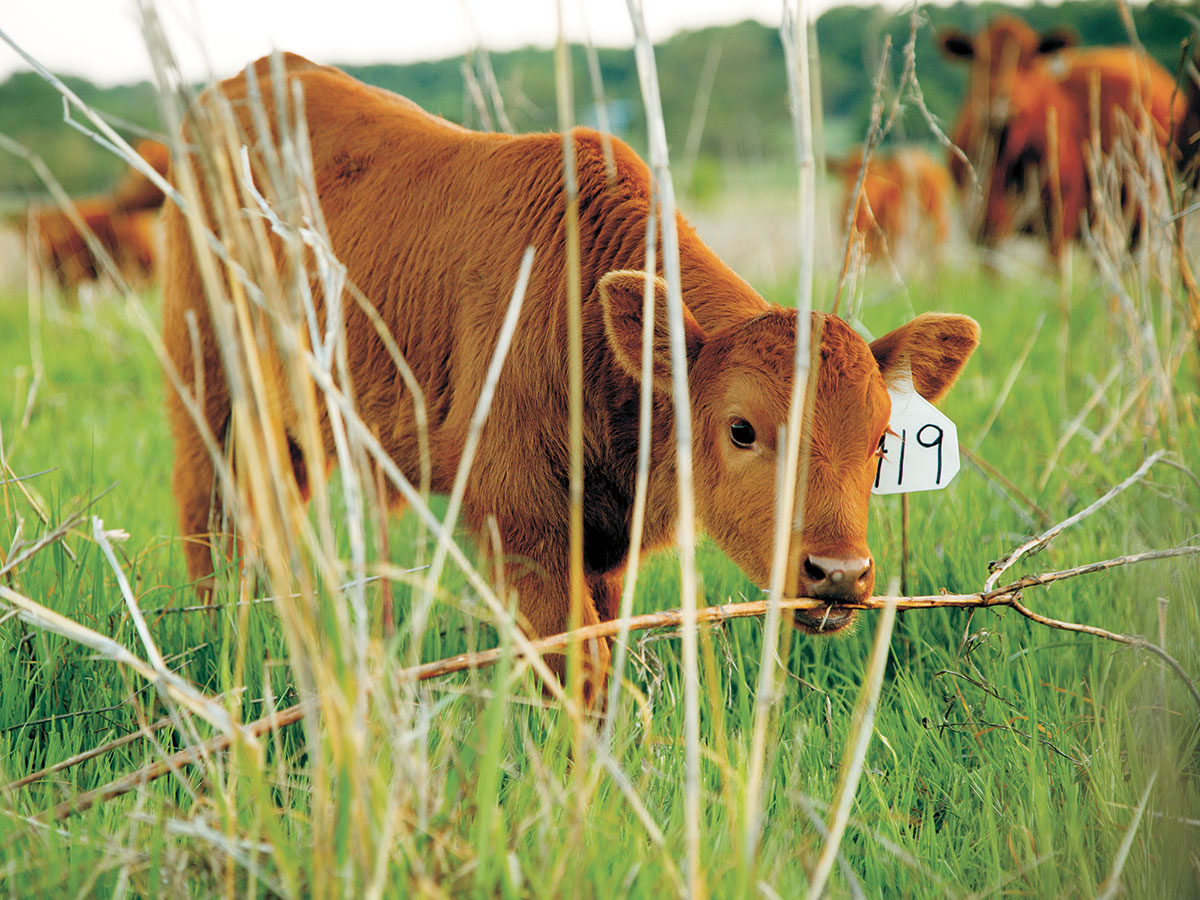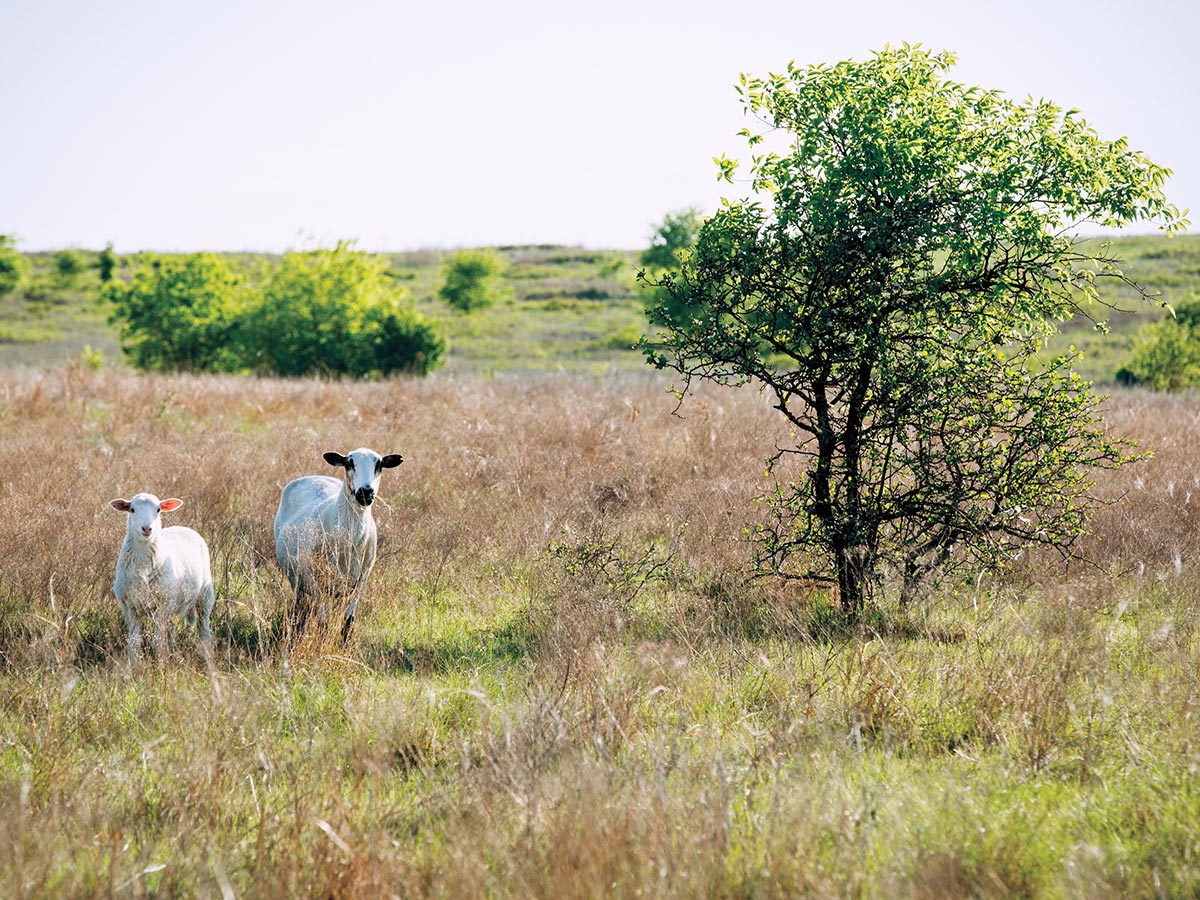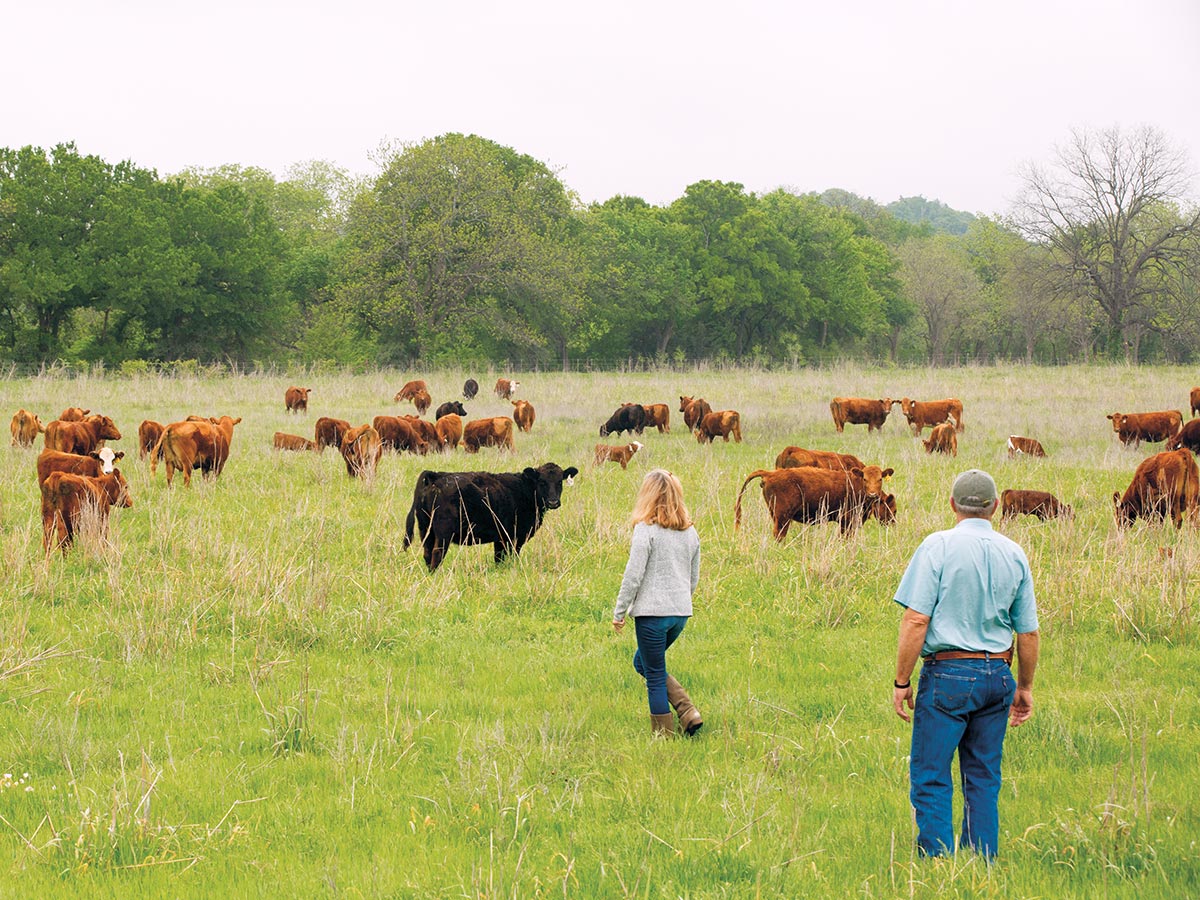America’s Next Top Model
There’s a fence in North Texas that tells a story. On one side, green spring growth is beginning to dot a native tallgrass prairie still primarily dressed in the dormant browns of winter. Cattle and sheep (and the occasional goat) wander and eat. They’re contained in paddocks roughly 20 acres in size, where they’ll live and eat for a day or two before moving on. Each new paddock greets their hunger like a freshly stocked salad bar, and they relocate with enthusiasm. Sheepdogs circle and protect the herd during more vulnerable hours, later snoozing nearby after a morning’s hard work.
On the other side, grass and soil slip down a softly graded hill like frosting melting o a cake — a telltale sign of erosion. The land is open for livestock to wander as far and wide as they choose, yet they’re all in one place: crowded around a trough, packing in to eat hay or cottonseed range cubes and defecating where they stand as flies buzz about. A short, homogenous crop covers the land, greener than the dusty shades of native prairie on the other side; deep cuts are conspicuous in the green where the land has broken. No sheep or goats or dogs around, just cattle that don’t look quite as shiny and healthy as those on the other side of the fence.
Clearly, one of these situations sounds better for both land and cattle. And one of these ranches requires harder work and more money. It’s not the one you think.
Grazing for the Grass
When Tom Bookhout began ranching in the late ‘70s, he spent more money and worked harder: “I plowed the bottom, and I fertilized, and I sprigged it with Bermudagrass,” he says. “It was done quite well, and we were making a lot of hay, but the bottom line was we weren’t making any money.” That’s when he started looking for alternatives.
It was when Bookhout saw Allan Savory and Stan Parsons speak on the subject of holistic land management in the early ‘80s that he found his alternative. Savory and Parsons — founders of the Savory Institute and Ranch Management Consultants, respectively — were instrumental in demonstrating that sustainable land management can be both pro table and good for the environment. Bookhout gave their methods a shot; when his mentor (and father-in-law) Clint Josey saw the results, he became trained in holistic management himself.
Josey is now chairman of the board of directors at the Dixon Water Foundation, which was founded in 1994 by Josey’s childhood friend Roger Dixon. The Dixon Water Foundation owns and operates four cattle ranches — the Mimms Unit in West Texas and the Leo, Pittman and Bear Creek Units in North Texas — and promotes healthy watersheds through research and educational outreach.
By managing land holistically, the foundation takes advantage of what author Michael Pollan calls “one of nature’s underappreciated wonders”: “the coevolutionary relationship between cows and grass.” And they do so to the benefit of their cattle, land and water quality, human beef consumers and their own pocketbooks. “We learned that you have to use the cattle as a tool to increase the grasses,” says Bookhout. Once they started doing that, everything changed.

A calf at one of the Dixon Water Foundation’s North Texas ranches helps native grasses grow by eating a little, walking a little and then moving on to a new paddock. As grasses regrow, they take carbon from the air and put it back in the soil. PHOTO Sarah Wilson
Rather than plant non-native grass, spray it with herbicides and feed it fertilizer to keep it growing while livestock graze it to the ground, the Dixon Water Foundation implemented rotational grazing at its ranches, using easily movable electric fencing to section land into paddocks where cattle graze for short periods, then move on to literally greener pastures.
Bookhout (now caretaker of the Josey Pavilion, a facility at the Leo Unit that received Texas’ first
Living Building certification) says putting up and taking down the fencing is a “one-person job.” In fact, “fence” almost seems too strong a word. It’s simply a wire strung between temporary posts and charged with electricity. Cattle get the hang of things pretty quickly, and moving fencing gives ranchers an opportunity to interact with their herds regularly.
“You’re just duplicating the bison and the days when they would let the land rest and then come back to it.”
“You watch ‘em,” says Melissa Bookhout, Dixon Water Foundation’s education program director and secretary/treasurer (also Tom Bookhout’s wife and Clint Josey’s daughter). “You’re seeing who looks good, who looks happy. They keep moving along … and getting fresh grass.”
They’re not only getting fresh grass, they’re tending to it: Through stomping and grazing (which encourages growth when it’s not overdone), as well as nutrients added by manure and urine, the cattle are tilling and feeding the very land they graze. “You’re just duplicating the bison and the days when they would let the land rest and then come back to it,” says Melissa. The addition of sheep and goats helps keep shrub growth down, and they don’t compete with cattle; each likes to eat different plants. In short, the animals take care of the land, and the land takes care of them right back.
“It’s a great business move,” says Tom. “It cut our expenses by just about half the first year. You could see the difference [in the land]. You knew it was going to change.”
One might assume a “grass-fed, organic beef” sticker is what rakes in the cash at the grocery store or meat market, but Tom says the most profitable thing they do is save money on antibiotics and medical care: “We just do not have sick animals.” They also save on hormones, fertilizer, machinery, labor — and herbicide, which cattle (and in the end, humans) are healthier for not ingesting.
Now, the Dixon Water Foundation continues the trend inspired by Savory and Parsons by not only making money, but by educating anyone from elementary school and college students to other land managers about what they’re doing and how it works. “There are a lot of people that feel like the cattle are ruining the land,” says Melissa, “but we want to prove that you can improve your land with animal impact.”
No Land No Water
In the words of Allan Savory: “Ultimately, the only wealth that can sustain any community, economy or nation is derived from the photosynthetic process — green plants growing on regenerating soil.” So how is all of this good for soil? And where does water come into the equation?
Essentially, after cattle are moved off land that has been briefly grazed, plants regrow. As they do so, they take carbon from the air and put it back in the soil. Carbon-rich soil is better at soaking up rainfall, which helps grasslands weather periods of drought and reduces erosion by supporting healthy root systems. Healthier soil encourages biodiversity, which benefits the myriad creatures that depend on grasslands for habitat and food.
There’s a big-picture benefit when it comes to greenhouse gas emissions as well. According to a study by Dr. Richard Teague of Texas A&M AgriLife Research, “Adaptive multipaddock grazing results in more carbon sequestration in the soil and produces a higher quality grass that reduces methane production.” Which is not to say methane isn’t an issue when it comes to cattle; cows naturally produce it as part of their digestive process, and experts differ on how much well-managed land can mitigate that production. Dr. Rattan Lal of the Carbon Management and Sequestration Center at Ohio State University says carbon sequestration “can’t completely compensate for the greenhouse gases in beef production,” though he does support well-managed, grass-fed beef.

Indiangrass (Sorghastrum nutans), little bluestem (Schizachyrium scoparium), and switchgrass (Panicum virgatum) at Dixon’s Leo Unit. PHOTOS Sarah Wilson
“Well-managed” refers to multipaddock, rotational grazing rather than continuously grazed land. Dixon General Manager Casey Wade, who works at the Mimms Unit near Marfa, uses a solar panel-and-battery analogy to illustrate the difference: He says a leaf of grass is just like a solar panel, collecting sunlight and turning it into energy. That energy is then stored in a battery — in this case, a plant’s roots. “When a cow bites off the solar panel,” he explains, the stored energy in the battery (roots) grows a new solar panel. With traditional grazing, that stored energy is eventually depleted. First, the new solar panels aren’t as high quality, and, eventually, the battery can’t produce new solar panels at all.
With rotational grazing, the batteries have months or even a year to regrow solar panels, so the solar panels are “lush and green and tender” when cows come back. And their batteries have been storing energy (and growing deeper and wider, creating what some call an “upside-down forest”) in the meantime. In the case of the cattle at Dixon’s Mimms Unit (where paddocks are a much-larger 250-300 acres), that energy is eventually consumed by humans buying grass-fed beef at Whole Foods, completing, as Pollan puts it, “a sustainable, solar-powered food chain that [transforms] sunlight into protein,” something he says makes “superb ecological sense.”
Dixon’s four ranches plus some recently acquired land make up more than 24,000 acres, all of which operate using holistic methods. That’s a lot of land being managed specifically with water quality in mind. As Tom Bookhout puts it, healthy soil and healthy grassland means “you’ll have a healthier watershed.” Industrial beef production, on the other hand, not only uses more water by feeding cattle irrigated grain crops (for at least part of their lives), it contaminates runoff with fertilizers, herbicides and mismanaged manure.
If you live in Texas, you may have noticed four giant words on Texas Agricultural Land Trust billboards along Interstate 35: “NO LAND NO WATER.” They’re part of the trust’s campaign to promote “working land naturally” in order to improve water quality, and the truth of that statement is why “water” is in the Dixon Water Foundation’s name and mission. “All of us depend on healthy rivers and streams, groundwater resources, and that depends on how land is managed,” says Dixon President and CEO Robert Potts in the 2015 PBS documentary “Treading West Texas Waters.”
Tom says that when it rains on their watershed, “if you can find a place where all the water is congregating, it’s usually clear.” He contrasts this with land that has “nothing to hold the ground,” where runoff is visibly filled with soil. Melissa chimes in: “At the Pittman [Unit], when those ponds ll up, you could go swimming; you could drink it.”
You can also tell by how the ground feels.“When I walk out into a pasture,” says Tom, “I like to use my feet as a tool to see how soft the ground is. Usually when you walk out into that tallgrass, you’re walking on sponges.” And even though they “plowed it all up once,” Tom says the grass is coming back native. At the Pittman Unit, the variety of colors and textures, even in early March, are evident of “the “big four”: little bluestem (Schizachyrium scoparium), big bluestem (Andropogon gerardii), Indiangrass (Sorghastrum nutans) and switchgrass (Panicum virgatum) — with a touch of Eastern gamagrass (Tripsacum dactyloides) in the mix.
When her father bought the property in 1996, Melissa says, “It was bare ground. There was absolutely no grass on the top.” Now, “it’s recovering,” she says. “The seeds are there.” They just needed animals to activate them.
Art of the Matter
That story of recovery is proliferating through the foundation’s research partnerships, field days for children, land manager training and higher education. They’ve established a Josey Institute for Agroecology at North Central Texas College and a partnership with Sul Ross State University, both of which now o er sustainable ranching programs that “are teaching kids to be … not just ranch managers but land managers,” says Melissa.
Members of the Wildflower Center’s Ecological Research and Design team were introduced to the Dixon Water Foundation on an educational field trip of their own: They paid a visit to the Mimms Unit on a side-trip from Marfa’s Chinati Foundation, a contemporary art museum that’s working with the Wildflower Center and others on a new master plan.
The ecological design team was so impressed with the land management results at the Mimms Unit that they’re including on-site cattle as part of their recommendations to the Chinati Foundation. While the Center champions — and frequently employs — controlled burns as a grassland restoration technique, Environmental Designer Michelle Bright says, “Prescribed re can’t happen everywhere.” She calls rotational grazing “the animal side of grass restoration” and sees it as an ideal method in a situation like Chinati’s, where they’re extremely concerned about their outdoor art installations.
“You’ve just gotta get over your paradigms. You’ve got to use a new model.”
The Mimms Unit’s Casey Wade, who previously worked for a wildlife management consulting rm, has experience with re and calls it an “excellent tool, especially for brush management in tallgrass ecosystems on the eastern side of the state.” In drier West Texas, he says the problem is more often bare ground than woody encroachment. “Fire isn’t going to help that at all,” he says. “Large numbers of herbivores walking over it and breaking it up … stomping organic matter back into the soil … that’s going to facilitate growth and cover up that bare ground. They’re both tools in the land manager’s hands,” says Wade, “but cattle can do things that re can’t [and vice versa].”
One thing the Chinati foundation needs help with is an overabundance of native shrubs like whitethorn acacia (Vachellia constricta), creosote bush (Larrea tridentata) and various species of mimosa. Wade says that’s atypical around Marfa, but the Chinati Foundation is “a little lower where it collects water more,” and, so far, they’ve had no re or cattle maintaining the land, so they’re making up for lost land-management time. “On a smaller property [like Chinati], Wade says “goats might be a great choice to deal with that. If you cut it down with goats in the rst place, you could follow up with cattle only” for maintenance. It’s a matter of getting things o on the right hoof, so to speak.
But the Chinati Foundation isn’t in the livestock business. So can ruminants be effectively used to maintain land even if selling livestock isn’t the end goal? “That model is not really in the minds of people yet,” says Wade, “but I hope it gets there.” When asked if he could see “loaning” livestock to the Chinati Foundation, he says, “Absolutely. We should be able to work out an agreement where we bring cattle in and improve [the land] and take the cattle off. It’s workable and it’s time for that to be part of people’s land management.”

The Dixon Water Foundation raises sheep (and goats) in addition to cattle. By eating shrubs that cows would pass up, these auxiliary animals keep vegetation in balance.

Melissa (left) and Tom Bookhout interact with Dixon cattle on a daily basis, which helps them keep tabs on their health. “It’s neat to watch an animal when he’s excited to go to a new, fresh pasture,” says Tom. PHOTOS Sarah Wilson
The Good Older Days
Which leads us back to that other side of the fence. If it makes money, takes less work, and is good for land, animals, water quality and human food consumption, why doesn’t everyone ranch like the Dixon Water Foundation? The answers aren’t all that surprising: efficiency and habit.
Grain-fed cows reach slaughter weight quicker. Even cattle that are raised on grass up to a point (usually 600-800 pounds) are typically fattened on grain at a feedlot in the end. Pollan calls it “fast food” and credits “tremendous quantities of corn, protein and fat supplements, and an arsenal of new drugs” with getting steers to weight in a quick (but typical) 14 months. Casey Wade says the Mimms Unit’s grass-fed males go to Whole Foods after two years.
Also, change is hard. As economist John Maynard Keynes wrote, “Worldly wisdom teaches that it is better for reputation to fail conventionally than to succeed unconventionally.” Some ranchers are simply doing what they were taught by the generation before them — preserving the good old days. The Dixon Water Foundation, on the other hand, is getting back to the good older days, when bison dominated grassland ecosystems and grazed areas sporadically by nature.
They and others like them are beginning to set a trend. In the 2013 short film “Soil Carbon Cowboys,” Mississippi rancher Allen Williams says “We graze it, and then we get the heck o of it,” while Gabe Brown of North Dakota describes rotational grazing as “extremely low stress, because we’re working with nature, instead of against it.” But another rancher in the lm, who now swears by the multipaddock system, admits he was slow to change.
Tom Bookhout understands that. “There was some peer pressure [against it] at first,” he says. “I had neighbors that would look over and go, ‘Oh, he’s let his pastures go to H. E. double L. Just look at the weeds!’” But he began to see that the land was changing for the better. “You’ve just gotta get over your paradigms,” he says. “You’ve got to use a new model.”
When it comes to managing land with livestock, you might say the Dixon Water Foundation is America’s next top model. But, as their staff will tell you, the real top model is nature itself. After all, they’re merely replicating her style. As Tom says of the animals at the Leo and Pittman Units, “We just let ‘em do their thing naturally.”

